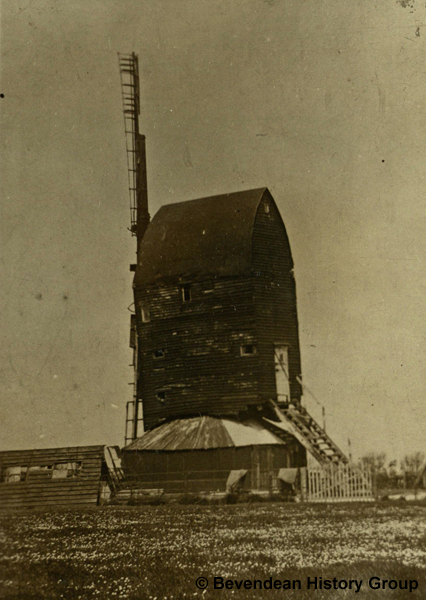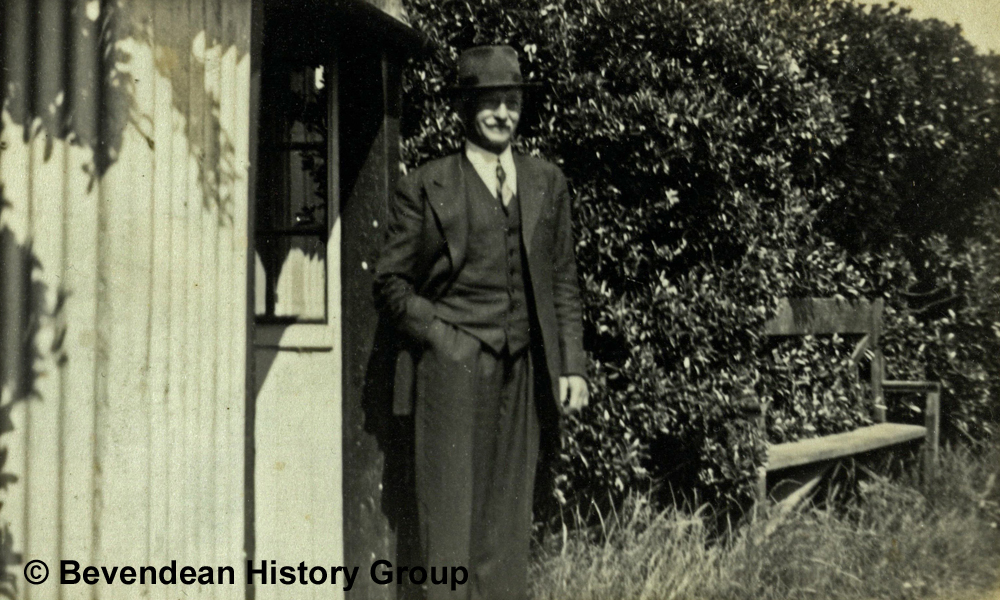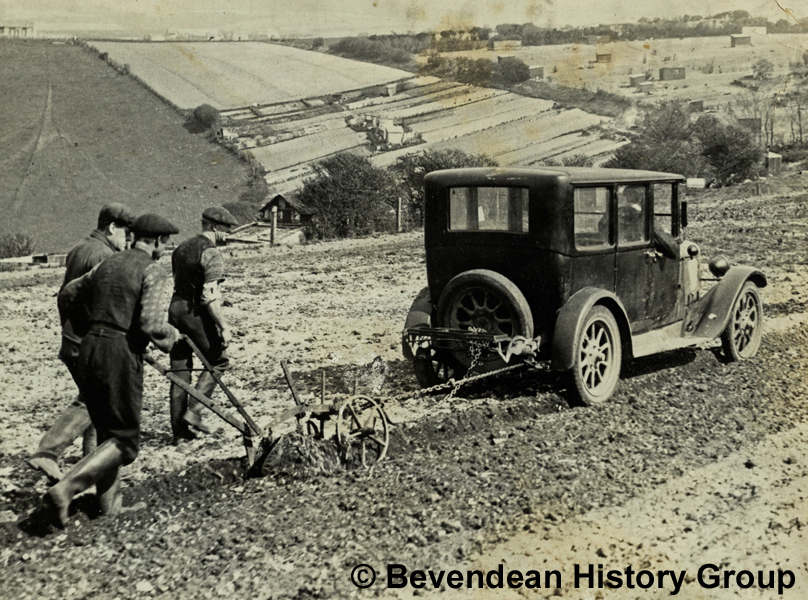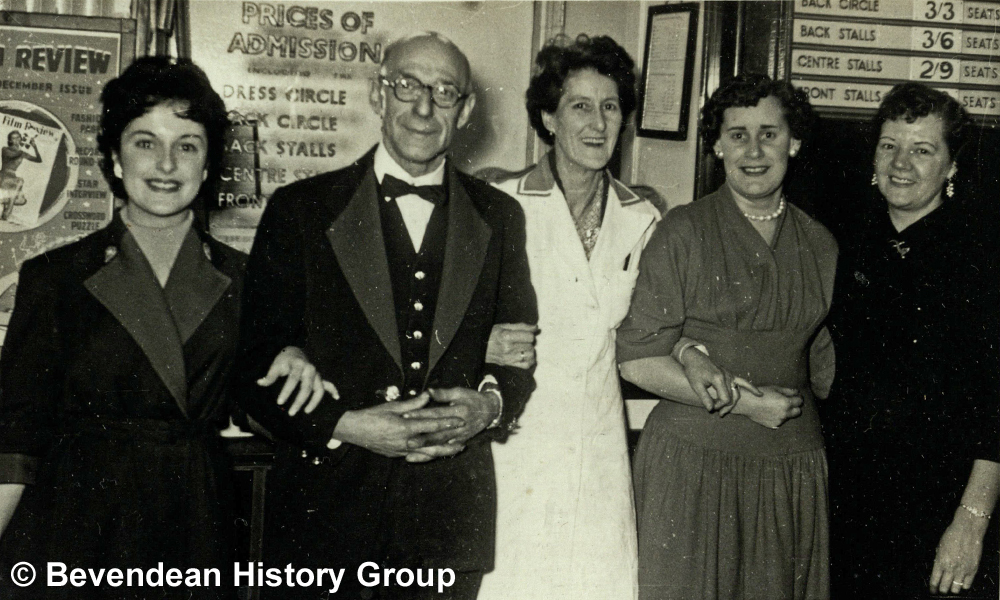
Peoples Stories - Bevendean History Project
Pearl Brown's memories continuedMy
father-in-law Mr Arthur Potiphar who was born in 1894 and he died on 12
April 1966. He was born at Steyning. Eventually he must have moved to
Windmill House Farm, Race Hill.
In 1941 aged 47 when he married my mother-in-law, Arthur's father Edward was a master gardener because I found that on his death certificate. I've got his death certificate and this was when they lived at Windmill Farm.
When my husband was about 9 years old he remembered going to where Arthur lived with his parents in the little shack with a corrugated iron roof. I have a photograph of the shack and a photograph of 2 men ploughing a field pulled by car. I have a photograph of the Windmill before it was blown down in a gale and also in 1914 after it was blown down and I've got a photograph of the wreck of the Windmill as well.
After that he worked at the Savoy Cinema on East Street. My mother-in-law met him there. She was a Londoner moved down from London during the war when her husband died. And that's how she got to know Arthur and married him. I have a photograph of the Savoy staff when he retired and as him as a doorman.
We did go to Sunday school and we went into the church, but I'm afraid I left because we were frightened that we might have to read the lessons because I remember some children were reading the lessons and we all left.
After the war we joined the Woodcraft Folk which was run by the Co-op for boys and girls and we met at Hanover Crescent in the basement of a building. It was very popular with the people who lived at Moulsecoomb, there were a whole lot of us who lived at Moulsecoomb and later we had to go to Moulsecoomb School to meet. We used to go hiking on a Sunday up Coldean Lane along Ditchling road to Ditchling Beacon and play games, have our sandwiches and then walk all the way back.
I used to love it at Hanover Crescent we used to play games and sing songs and with the boys we went camping at Keymer. The boys went into the woods to get the wood for the bonfire and they dug a trench for the toilets. I looked it up on a map I think it was called Bungalow Farm. We had to go there for our water and milk. We used to wash in the stream and wash our plates and knives in the stream.
We used to do Morris dancing and sword dancing, where we would hold the sword up in the air I used to like that. For the sword dance we had flat sticks which at the end of the dance we would weave together to make a star which was then held up high.
I used to ride a bike everywhere and we used to ride our bikes out into the country and pick loads of bluebells which was naughty when you think about it now because when we came home we used to see all these bluebells on the windowsills in jam jars. It was naughty really but we just didn't realise. There were bluebells everywhere but they all got droopy, they didn't last long.
The field behind Birdham Road was always a cornfield and the field behind Bevendean Crescent was for the dairy cows. We had this very friendly Jersey cow we used to call him Fred, which was silly because he was a lady and we used to stroke her she was a beautiful cow.
The farmers used to come and cut the corn and we kiddies went there. The corn was very sharp to walk through where it had been cut, it used to dig into your legs but we thought we were helping. The farmworkers used to stack the corn up to dry, and then they would build a lovely hay stack right over the top at the brow of the hill here. They were lovely days really when you look back.
The area has definitely changed; I think it's scruffier now than it used to be, we were so proud of the area. Funnily enough we always used to scrub the doorsteps, the steps at the front door and we children would do it more or less at the same time and then we would throw the water in the street to see which would go the furthest and we used to call it ‘tassers’. I don't know why.
We used to have comics and I used to go along the road and swap comics with my friends.
There was a Co-op that faced the barracks, in Coombe Terrace, my sister worked there, behind there was a nursery run by Mr Cooper.
There is the Lectern public house, now closed and then another pub which used to be called The Ship, which is now the chaplaincy office of Brighton University. Then there's a little gap and it used to be where the Co-op was. Behind the gap was a nursery gardens run by Mr Cooper because I used to go to school with his daughter.
There was a greengrocer in Coombe Road opposite where Grouts the bakers used to be.
When my sister left school she was 14, I left when I was 15 as they put the leaving age up. My sister, she worked for the Co-op up Queens Park Road as a cashier in the butcher's department because you had the butchers department and the grocer's department and then she was transferred to the Co-op in Coombe Terrace opposite Preston barracks.
I remember the barracks; I remember the old-fashioned buildings they lived in. The main entrance where you go in, behind there, is one of the old buildings now used by the cadets. And I think that's the oldest building on the barracks site. You can't see it from the road.
My sister worked in the Co-op as a cashier, you put the money in the machine and pulled the chain and off it went from the counter, and she had that down there in Coombe Terrace. In Coombe Terrace you had separate bakers, separate butchers departments and then you had the grocer's shop. You never had freezers in those days and I remember her going in after the weekend and there were little maggots on the bacon and they used vinegar to wash them off and then sell it. I know that people ate it, they didn't know any better because vinegar would kill the maggots.
Tamplins Brewery was in Waterloo Place on the Lewes Road side of St Peters Church. There was this great big building which had a huge chimney. My grandad worked there and during the war it got bombed, the blast threw him back and this frightened the life out of my mum, but he survived. Behind there are houses today.
My husband worked for the brewery in Kemptown for a little while as a young boy.
You will be lucky to find a photograph of Tamplins brewery now; pictures of the brewery just don't seem to have survived. My father sometimes had to travel all the way to Sheffield Park because they owned pubs all over the place and he used to go to Sheffield Park quite a lot to a big pub up there. They were always having problems. They had one plant in the town centre where Churchill Square is now, they had a well there but I think the seawater used to come into it. They owned the bottling plant there at one time it was where Canon Place is now. I remember my father had to go there now and again.
In Union Road opposite the level were the houses in Park Crescent. Round there years ago there used to be what was called the Grand Theatre, no I think it was the Gaiety Theatre, it was the circus and when it closed down my grandad had to go there and help clear out. I think when it closed as a theatre it was used as a bottling plant. I cannot remember what firm it was now. My grandad had to go there and clear it out and he came back with this glass which had the Gaiety Theatre on it and he kept it for years and years. After our father had died my sister and I, decided to give it the Museum, so Brighton Museum has got it, but they've never put it on show it is hidden away.
In 1941 aged 47 when he married my mother-in-law, Arthur's father Edward was a master gardener because I found that on his death certificate. I've got his death certificate and this was when they lived at Windmill Farm.
When my husband was about 9 years old he remembered going to where Arthur lived with his parents in the little shack with a corrugated iron roof. I have a photograph of the shack and a photograph of 2 men ploughing a field pulled by car. I have a photograph of the Windmill before it was blown down in a gale and also in 1914 after it was blown down and I've got a photograph of the wreck of the Windmill as well.
After that he worked at the Savoy Cinema on East Street. My mother-in-law met him there. She was a Londoner moved down from London during the war when her husband died. And that's how she got to know Arthur and married him. I have a photograph of the Savoy staff when he retired and as him as a doorman.
We did go to Sunday school and we went into the church, but I'm afraid I left because we were frightened that we might have to read the lessons because I remember some children were reading the lessons and we all left.
After the war we joined the Woodcraft Folk which was run by the Co-op for boys and girls and we met at Hanover Crescent in the basement of a building. It was very popular with the people who lived at Moulsecoomb, there were a whole lot of us who lived at Moulsecoomb and later we had to go to Moulsecoomb School to meet. We used to go hiking on a Sunday up Coldean Lane along Ditchling road to Ditchling Beacon and play games, have our sandwiches and then walk all the way back.
I used to love it at Hanover Crescent we used to play games and sing songs and with the boys we went camping at Keymer. The boys went into the woods to get the wood for the bonfire and they dug a trench for the toilets. I looked it up on a map I think it was called Bungalow Farm. We had to go there for our water and milk. We used to wash in the stream and wash our plates and knives in the stream.
We used to do Morris dancing and sword dancing, where we would hold the sword up in the air I used to like that. For the sword dance we had flat sticks which at the end of the dance we would weave together to make a star which was then held up high.
I used to ride a bike everywhere and we used to ride our bikes out into the country and pick loads of bluebells which was naughty when you think about it now because when we came home we used to see all these bluebells on the windowsills in jam jars. It was naughty really but we just didn't realise. There were bluebells everywhere but they all got droopy, they didn't last long.
The field behind Birdham Road was always a cornfield and the field behind Bevendean Crescent was for the dairy cows. We had this very friendly Jersey cow we used to call him Fred, which was silly because he was a lady and we used to stroke her she was a beautiful cow.
The farmers used to come and cut the corn and we kiddies went there. The corn was very sharp to walk through where it had been cut, it used to dig into your legs but we thought we were helping. The farmworkers used to stack the corn up to dry, and then they would build a lovely hay stack right over the top at the brow of the hill here. They were lovely days really when you look back.
The area has definitely changed; I think it's scruffier now than it used to be, we were so proud of the area. Funnily enough we always used to scrub the doorsteps, the steps at the front door and we children would do it more or less at the same time and then we would throw the water in the street to see which would go the furthest and we used to call it ‘tassers’. I don't know why.
We used to have comics and I used to go along the road and swap comics with my friends.
There was a Co-op that faced the barracks, in Coombe Terrace, my sister worked there, behind there was a nursery run by Mr Cooper.
There is the Lectern public house, now closed and then another pub which used to be called The Ship, which is now the chaplaincy office of Brighton University. Then there's a little gap and it used to be where the Co-op was. Behind the gap was a nursery gardens run by Mr Cooper because I used to go to school with his daughter.
There was a greengrocer in Coombe Road opposite where Grouts the bakers used to be.
When my sister left school she was 14, I left when I was 15 as they put the leaving age up. My sister, she worked for the Co-op up Queens Park Road as a cashier in the butcher's department because you had the butchers department and the grocer's department and then she was transferred to the Co-op in Coombe Terrace opposite Preston barracks.
I remember the barracks; I remember the old-fashioned buildings they lived in. The main entrance where you go in, behind there, is one of the old buildings now used by the cadets. And I think that's the oldest building on the barracks site. You can't see it from the road.
My sister worked in the Co-op as a cashier, you put the money in the machine and pulled the chain and off it went from the counter, and she had that down there in Coombe Terrace. In Coombe Terrace you had separate bakers, separate butchers departments and then you had the grocer's shop. You never had freezers in those days and I remember her going in after the weekend and there were little maggots on the bacon and they used vinegar to wash them off and then sell it. I know that people ate it, they didn't know any better because vinegar would kill the maggots.
Tamplins Brewery was in Waterloo Place on the Lewes Road side of St Peters Church. There was this great big building which had a huge chimney. My grandad worked there and during the war it got bombed, the blast threw him back and this frightened the life out of my mum, but he survived. Behind there are houses today.
My husband worked for the brewery in Kemptown for a little while as a young boy.
You will be lucky to find a photograph of Tamplins brewery now; pictures of the brewery just don't seem to have survived. My father sometimes had to travel all the way to Sheffield Park because they owned pubs all over the place and he used to go to Sheffield Park quite a lot to a big pub up there. They were always having problems. They had one plant in the town centre where Churchill Square is now, they had a well there but I think the seawater used to come into it. They owned the bottling plant there at one time it was where Canon Place is now. I remember my father had to go there now and again.
In Union Road opposite the level were the houses in Park Crescent. Round there years ago there used to be what was called the Grand Theatre, no I think it was the Gaiety Theatre, it was the circus and when it closed down my grandad had to go there and help clear out. I think when it closed as a theatre it was used as a bottling plant. I cannot remember what firm it was now. My grandad had to go there and clear it out and he came back with this glass which had the Gaiety Theatre on it and he kept it for years and years. After our father had died my sister and I, decided to give it the Museum, so Brighton Museum has got it, but they've never put it on show it is hidden away.

Photographs of the windmill at the top of Race Hill.
I have seen a movie of this place out at Hove Museum; they have got these old-fashioned movies. They have got an old projector and there is one film where there is the Miller throwing flour and the chimney sweep throwing soot at each other and it was filmed there.
This is the house they lived in with corrugated iron walls and roof, that would be Arthur's brother. It must have been a big family because there were 2 brothers and 3 sisters and they never married but I don't really know about them.

And this building was near the Windmill that was the name of the farm where he lived, called Windmill Farm.
This photograph with the 3 boys if you look down there you can see a little chalet, a Swiss chalet, and is somewhere up here. It is a pity we cannot get it clearer, I do not know if this is the Warren road or where it is. It looks like allotments or small holdings in the background. It somewhere up there on the Hill that they were ploughing. It is a pity you can't sharpen it up to see what it is all about.

I don't know if you know, but along Warren road where they built the Nuffield hospital there used to be a school, it was for boys who had lost their parents who used to live and go there. I think my father said that these youngsters in the photograph showing the ploughing behind the car might have come from that school. My grandmother Chapman, she was a governor to do with the Brighton General Hospital and my sister has got photographs of her and there's a book about Brighton General Hospital. They were connected with this Fitzherbert School in Warren Road.
I sent that picture to Adam Trimingham and he published it in the Argus years ago. (This is the picture of a car pulling plough). The ploughing photograph came from the Brighton and Hove Herald, date unknown. Maybe it was a few years after the Windmill was blown down in 1913.
Arthur Potiphar worked at the Savoy Cinema and that's where my mother-in-law met him and they got married, and there he is on his retirement with the staff. He looked so smart in his uniform, he was a lovely man.

This is some of the staff who worked at the Savoy with Arthur.
I didn't realise but there was a dance hall in the building and a restaurant like in the Regent Cinema. You know how they advertise the films it was his job to put it up the films titles etc., he could have brought them home and saved them, they would be worth a fortune now.
I worked repairing stockings; it was 6d a ladder for each repair. Stockings were very expensive and so it was worth repairing them when they got a ladder or tear in them. People used to take their stockings into Courtney King Drycleaners and they would send them to Glenn Hose, a company run by Mr and Mrs Whitehead in Edward Street. The stockings would then be sent to people including me to repair them. It was rather tedious and not always easy.
Sometimes the girl repairing the stockings would sit in the drycleaners window so that people passing by could see what they were doing. One day I looked up and my aunt was watching me.
20 January 2016
| More Photographs | More about Racehill Windmill |

Story_022b